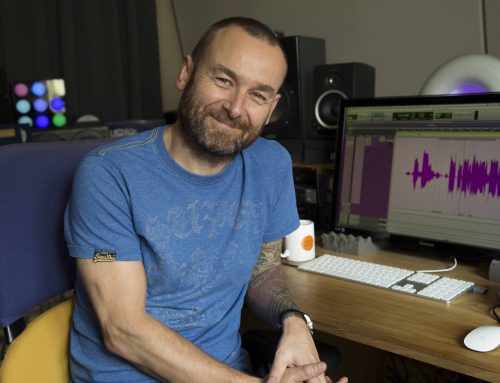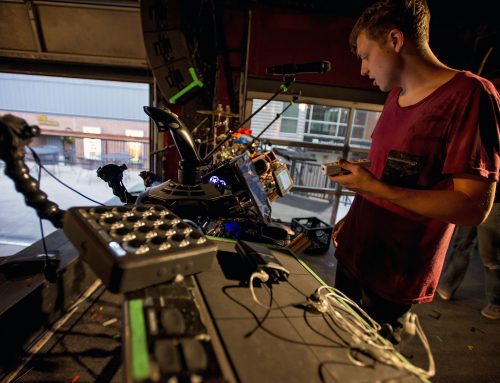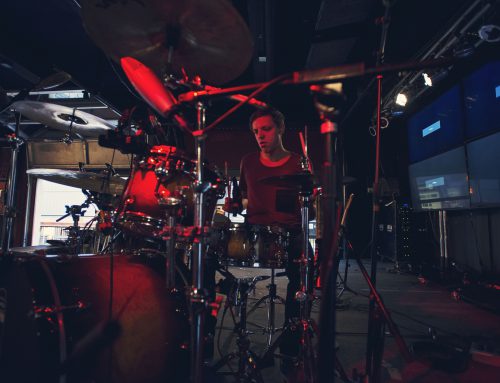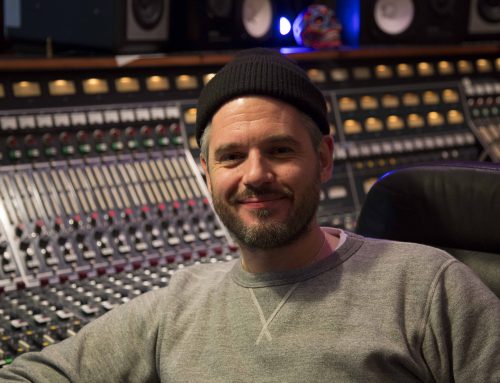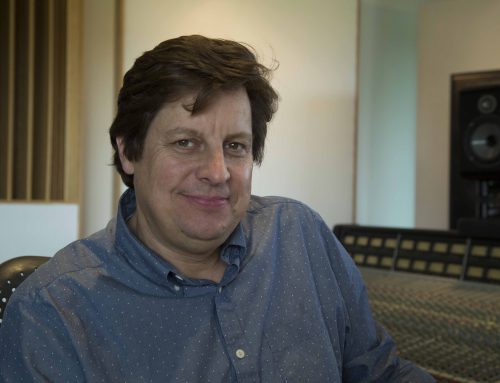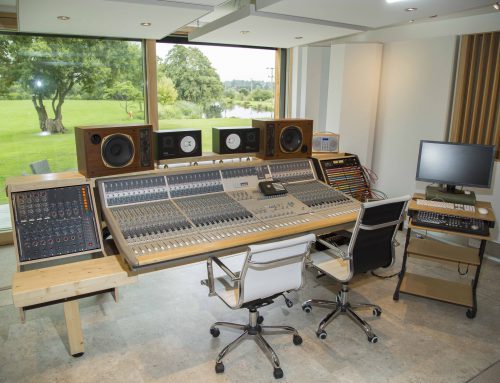When Olympic Studio closed at the start of 1999, Stephen Street had to find a new production base. He and fellow producer Cenzo Townshend had been sharing a general production room at Olympic, using the main studios in the complex for larger recording and mixing jobs. It took Stephen over a year to find a suitable replacement, but now he is settled once again. Stephen explains why his new studio, The Bunker, is the ideal location.
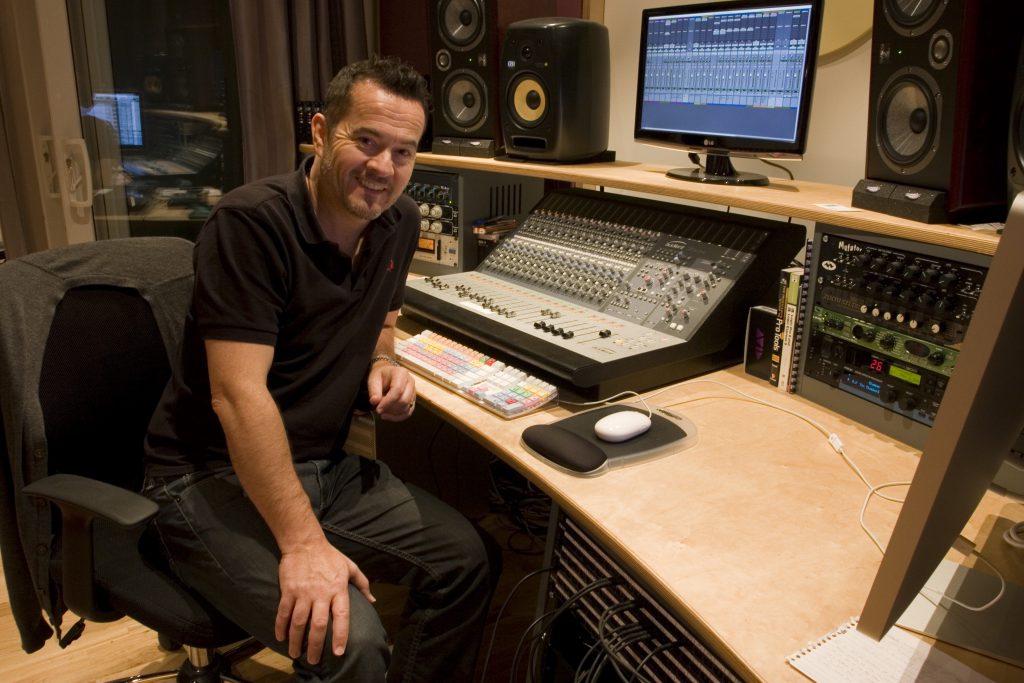
Stephen, photographed from the door to his studio
“I think it is good for any producer these days to have a base of operations, “says Stephen Street. “I used to share a space at Olympic studios with Cenzo Townshend, but unfortunately the studio closed down nearly three years ago, so I was looking around for a while, trying to find a decent space to move into and set The Bunker up again. Some of the studios I looked at were on industrial estates and they just didn’t seem to be places where I’d be amongst creative people.
“It took a while but eventually Miloco came along and I was called in by managers Siobhan Paine and Nick Young to see I’d be interested in taking a space they were considering building within the Miloco building. Their plan was to turn a garage space into a room and I jumped at the chance.
“It was literally a storage area and within that space they built a room-within-a-room structure. It was just a neutral space and I simply brought all my equipment into it to turn it into The Bunker as we now know it.”
Inside The Bunker
Hidden deep within the Miloco complex, The Bunker is a small windowless studio, divided into two spaces by soundproofed sliding glass doors. The main entrance opens into the larger area which contains Stephen’s recording and mixing equipment, including his DAW, mixing desk, processor and effects racks and monitor speakers. Against the back wall, flanked by small corner tables and lamps, is a sofa where studio guests have room to sit and listen to mixes. The smaller room is for recording guitars, vocals and any other overdub parts which don’t require a large studio space to record. Stephen explains his reasons for creating the two areas within The Bunker.
“The Bunker that Cenzo and I had at Olympic had a designated recording space and I definitely wanted that. I was adamant that I needed some kind of overdub space where I could rig up guitar amps, record vocals and, if I had to, a little bit of percussion too.
“I didn’t want it just to be a programming room because I am not really known for producing things that are highly programmed. I’m not keen on programming rooms as such; I think they are fine if you are doing everything in the box and rely on samples all the time. This time around I couldn’t get as much space as we had at Olympic because of the dimensions that were available to build in, but I was pleased with what we achieved in the end.”
Although The Bunker is more than just a programming room, it clearly isn’t designed for recording bands. Nevertheless, because it is part of a larger recording studio complex, Stephen has easy access to the rest of the Miloco facilities.
“This is the good thing!” he insists. “Because I am within the Miloco building it is similar to what I had at Olympic in the sense that I can go into one of the bigger rooms to record if I need to. There’s The Pool, as it’s known, which is right next door to me, so if I’m tracking with a band who are using a fully-blown drum kit and everything, I can do the tracking there. Or I can go to Assault and Battery, or any of the other Miloco studios.
“There’s also an SSL room at Miloco called The Engine Room which I often use if the budget is there. But sometimes there isn’t the money and that is when I need The Bunker. Some of the bands I work with are not even signed, but I am working with them because I think there is something interesting there. Because there is a lack of budget I need somewhere where I can at least be creative and finish off projects that I am working on. When it gets to the stage where I am finishing off overdubs I can do that in The Bunker and I’m now mixing things here as well.”
Clearly having The Bunker at Miloco headquarters is very good from a practical point of view, but Stephen also finds it artistically inspiring to be amongst other people working in the music industry.
“There are quite a few rooms here so you are in this creative environment,” he explains. “Ben Hillier, for example, is in the building and he is a great engineer/producer. Sometimes he’ll talk to me about a new processor he’s bought and one time he lent me a really good stereo compressor. Microphones and other bits of equipment are leant out to people and it just feels very creative and inspirational to be in the building that’s full of musicians, programmers, engineers.”
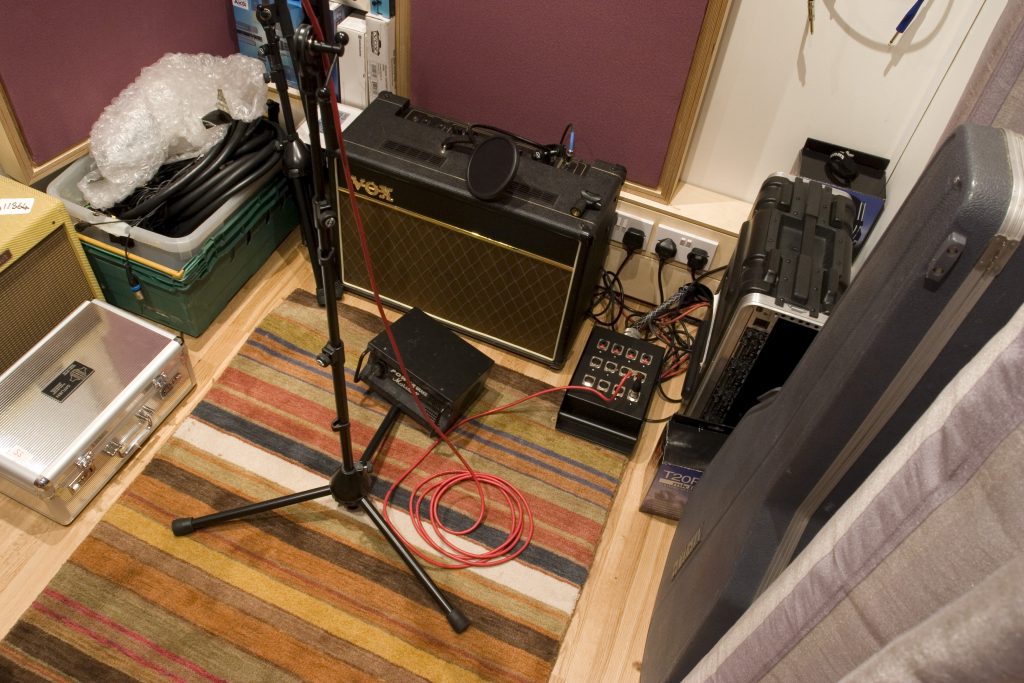
Inside the small live room
Inner Space
At the centre of Stephen’s control room is his Audeint Zen analogue mixing console, which he bought to replace the Audient ASP8024 desk he and Cenzo Townshend worked on at Olympic. Most of Stephen’s track recording sessions are done in other studios with suitable live rooms and recording equipment, so the Zen is mainly used for overdubbing and mixing duties. In general, the Pro Tools sessions he has recorded are fed out via his two Avid I/O interfaces and into the desk via a patchbay, where they are mixed using the Zen and various bits of outboard gear.
For Stephen, the desk provides just the right combination of features. It not only offers high-quality analogue mixing channels, but also the ability to use it in conjunction with the automation system of a DAW. Stephen explains exactly what he loves about the Zen.
“We had an Audient desk in the last room which was great to work on but Cenzo sold that when we moved out so I had to get myself a new desk. When I heard about the Audient Zen I thought it was a great coming together of ideas. Firstly, you’ve got the analogue side of it – the mic amps, compressor built across the stereo buss and so on. I believe that Audient have put exactly the same compressor into the Zen as the great stereo compressor that was built on the original Audient desk that we used before. So I tend to have that across my mixes all the time when I am finishing mixes.
“Then, secondly, there is the wonderful way the main faders configure with the MIDI in Pro Tools. So when I am mixing I can do a certain amount within DAW and some outside the box where it is easy to patch in analogue compressors, EQs and things. As well as the main stereo buss you have got four other busses. There is Stereo One, Stereo Two, Mono One and Mono Two so I can route my faders to those subgroups and insert different things across those busses. It is great for applying parallel compression and those kinds of things.
“I’ve got two Empirical Labs Distressors which I am a very big fan of. They are not actually a stereo pair so I tend to line them up by ear and looking at the meters and get them operating as equally as I can.
“I love using them across the drums. I think they are really good for that. I tend to use them on the normal setting with a 6:1 ratio, which I find works quite well, and I use a slow-ish attack and fast release. I also use the HP detector which bypasses the low end so that the bottom of the kick doesn’t start making it pump too much. I find I get pretty good results with that button pressed in. “There’s an Urei 1178, which is like two 1176s and also the Audient Black Series compressor which is very nice and subtle. And then I’ve got an API Lunchbox and some nice EQs.
“So I’m managing to find a nice compromise, mixing half-in and half-out of the box. It just gives me the best of both worlds. I can patch my outboard across either the separate channel inserts or the sub-group inserts and with the combination of those and the plug-ins I’ve got within Pro Tools I am managing to get good results.”
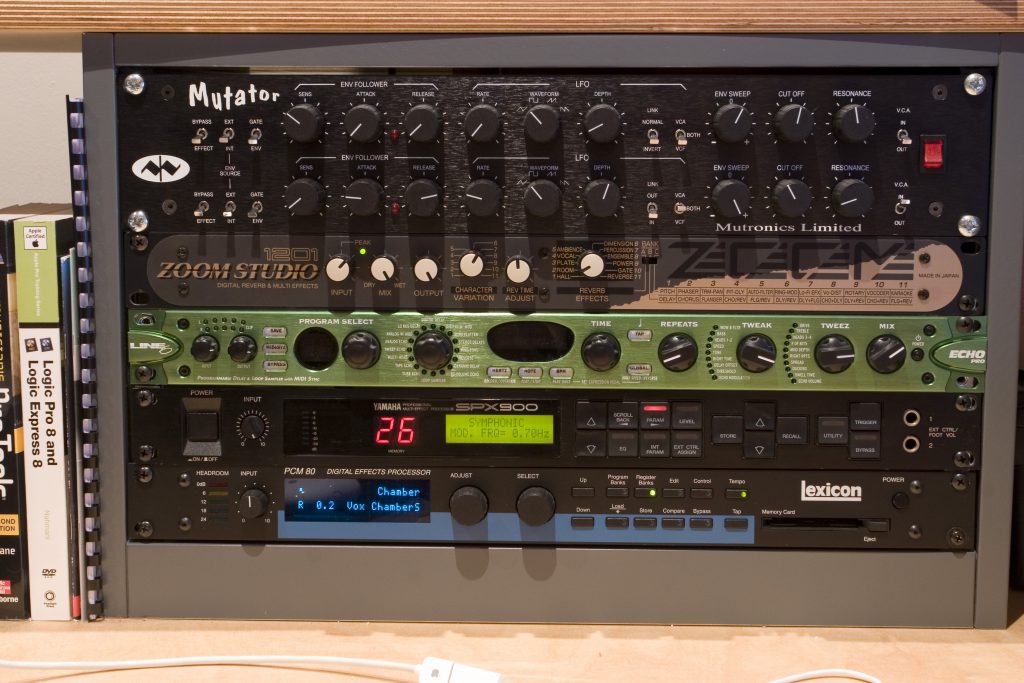
The effects rack
Zen Control
Stephen does not use Logic Audio’s sophisticated MIDI facilities to control the Audient Zen, but chooses to run it straight from within Pro Tools, using a simple technique recommended by Audient themselves.
“On the Audient you have got 16 main faders,” Stephen explains, “so if you create 16 blank tracks at the top of the Pro Tools session, within those you can record the movements of each Zen fader as MIDI data. Then, when you come back to mix on the desk, those faders can map back exactly to where they were. So by doing that your desk fader movements are remembered within the Pro Tools session. And obviously you can save things like notes about what compression you’ve use on each channel. I just make a note in the comments box and then if I need to recall a mix I can get back to pretty damn close to where I left it.
“What I tend to do is have drums coming up on the first two faders, rhythm guitars on Three and Four, lead guitars on Five and Six, bass on Seven, lead vocals on Eight and Nine and 10 will be backing vocals. 11 and 12 are usually for keyboards, percussion and that sort of thing, and 15 and 16 have all my reverbs and delays coming back.
“Also on the Audient you’ve got alternative line inputs that you can patch into and that gives you another 16 channels which are controlled via rotary volume knobs.
“I’ve got a Lexicon PCM80 reverb which I love – I still think the Lexicon reverbs are the best – and I’ve also got an old Yamaha SPX900 classic, which I think are fantastic units as well. I can patch those into my alternative inputs so it’s a half-in, half-out the box arrangement, which I find is a great way of mixing nowadays.”
Stephen has his Lexicon PCM80 and Yamaha SPX900 patched into a send/return loop using Avid HD I/O interface and three Signex Isopatch Bantam Pro Series patchbays. He explains a little more about how his I/O is set up.
“I’ve got the new Avid I/O which has 16 outputs and they are routed to my 16 main faders on the Zen. Then I tend to use the first two outputs of my old Avid 192 unit going straight out as sends to my PCM80 and SPX900 and it seems to work really well. I basically create a buss output to those units in Pro Tools. At first I tried to do it without a patchbay but I soon realised that to make it work you really do need to have a one. So there’s a good old-fashioned patchbay in the room as well.
“Another thing that I did was have a wooden desk custom made for me to make good use of the space available in the room. It great because it means the Zen can go in the middle, my compressors are on the left, reverb units are on the right, and it gives me a good shelf to put my monitoring on. I’ve also got the patchbay and I/O on the lower right-hand side of the unit. So it just makes everything nice and tidy and gets a lot of equipment into a relatively small space.”
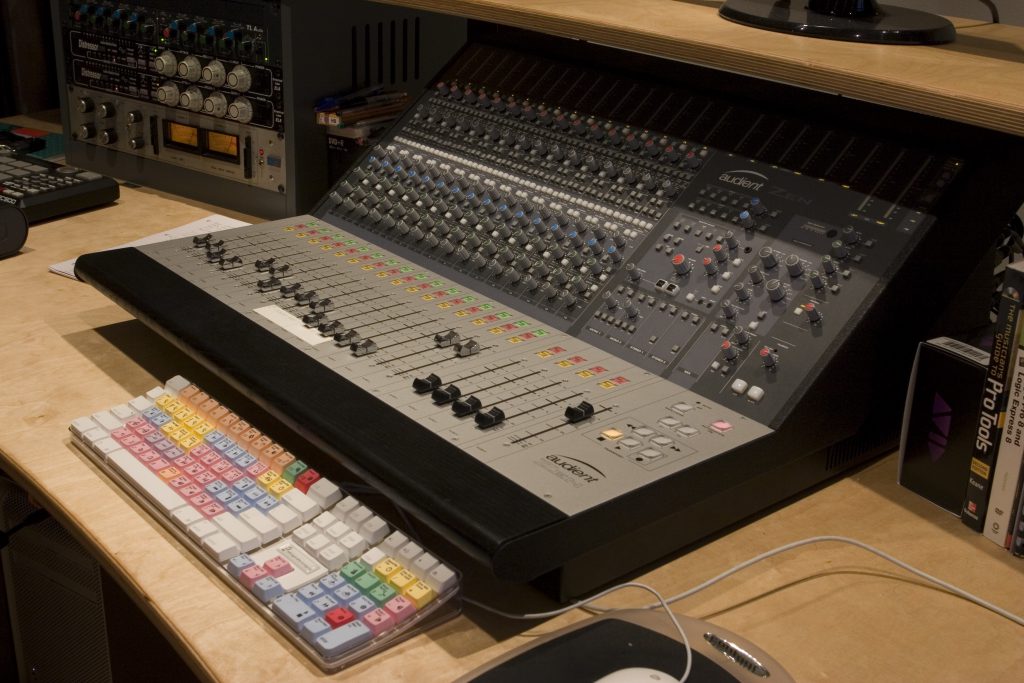
The Audient Zen
Recording and Processing
Stephen now uses a Pro Tools HD3 Accel system, with eight inputs and 24 outputs and Avid converters, but he admits that when the Pro Tools first came out he avoided using it for many years. Stephen’s preferred recording system was the Otari Radar, which is one piece of equipment notable for its absence from the new setup. He explains what he loved so much about the RADAR and why Pro Tools has finally taken its place.
“I still think the Radar it is the best sounding unit out there – it’s incredible, although it hasn’t got all the plug-ins and editing facilities that you have within Pro Tools. I think I was one of the first people to buy a RADAR in this country and used on the fifth Blur album which had ‘Beetlebum’ and ‘Song 2’ on it. That RADAR was only 16-bit but it sounded incredible and I loved it to death. They I progressed on to the RADAR 2 when it came out and I used that for many, many years. I did look into the possibility of taking the converters out and using them because they are doing an ADA now which is a box you can use as a front end to a Pro Tools system, but unfortunately the cost of it was so much that it wasn’t very feasible really. It was just a bit too much money. So I decided to go down the route of the new Avid I/O, which I’m very please with because it does sound very good.”
Although Stephen’s hardware processors still play an important role in his production work, he has embraced the world of software plug-ins, including the Bomb Factory bundles which come as standard with Pro Tools.
“Plug-ins have definitely improved in recent years and sound a lot better than they used to. At first there were a lot of people using their eyes rather than their ears. If a plug-in looks pretty people go ‘Wow!’, but plug-ins are now beginning to sound good as well as look good. Avid have definitely picked up their game in recent years. For many, many years Logic was way ahead of Pro Tools on that front but Pro Tools is catching up, without a doubt.
“My favourites include the Sound Toys Echoboy delay which I think is a great sounding unit. I also like the Waves Chris Lord-Alge Classic Compressors package – the CLA as it is called. And I also really like the Waves SSL collection, especially the SSL E-channel. I use that a lot on my drums. I find it’s really useful for getting a little bit more kick into kick drum and for bolstering toms so I often patch it across separate drum channels.
“Recently I bought the Waves Kramer PIE Compressor. That is really good to use if I can’t get quite what I want out of the Distressors or my other hardware compressors. If I have used it early on in a session and managed to get the drums sounding right using just that then I leave it in place. I also really like using it on bass guitars and vocals.
“The Eddie Kramer bundle includes an EQ which is the HLS Helios EQ. The mid range on that I find very sweet for electric guitars and I like that very much too.”
One of Stephen’s favourite new tools is Avid’s HEAT, which stands for Harmonically Enhanced Algorithm Technology. HEAT simulates analogue warmth, but operates across all the channels of a mix simultaneously, thereby replicating an analogue desk or tape output. It also means that the user does not have to keep track of individual instances of the plug-in and can control its actions globally.
“It’s a general kind of EQ and compressor that works over the whole session,” explains Stephen. You could have it just over a stereo buss but I tend to have it over every individual channel. In a way it’s like putting every channel through an analogue desk because it warms things up a little bit or adds a little bit of soft compression. I can’t quite put my finger on what it does, but whatever it does do I find it definitely helps the bottom end and depth of the mix.
“There’s an overall drive control but if you don’t like what it is doing to a particular channel there is a bypass for each channel. But, in general, I find that subtle application HEAT really helps and works pretty well over everything. I am mixing outwards into the Zen desk and using the HEAT on each musical channel so I wouldn’t put it across the mix channel or any sub groups because that would be over doing it a little bit, I think.”
Although Stephen has succumbed to the lure of plug-ins and virtual instruments, he has not completely abandoned his synth hardware. His old Roland Super JV1080 still has a place in the studio, and one of his favourite keyboards is Korg’s MicroKorg.
“The JV1080 is great for some things,” says Stephen. “I have the JV80 Orchestral and World expansion boards in there so it has got some nice ethnic-sounding instrument. It’s not been used a lot in recent years, I must admit, but it is good to have there and it’s nice to dip back in every now and then for some sounds.
“I’m a big fan of the little MicroKorg. It’s a great sounding little unit. If you play around with it and shove it through guitar amps and process it, it sounds even more interesting. It’s just nice to still have those old keyboards. I’ve also bought the Miroslav Vitous Symphonic Orchestral library which is very useful for string samples.
“As for mics, I’ve been using the Sure SM7B microphone quite a lot recently, especially on rock vocals. I find that a really good microphone. I haven’t got as many mics as I’d like at the moment just because I spent so much money buying other things last year, but I will adding to my collection over time. If I do need something fancy, as long as it is not being used by any of the other studios, I am usually able to get hold of it from within the Miloco collection.
“There are some mics that Cenzo and I had in the studio at Olympic which are in storage now and I just need to get those dug back out. There was an Elam mic that I liked using quite a lot, so there are things like that to come back into the studio.” TF
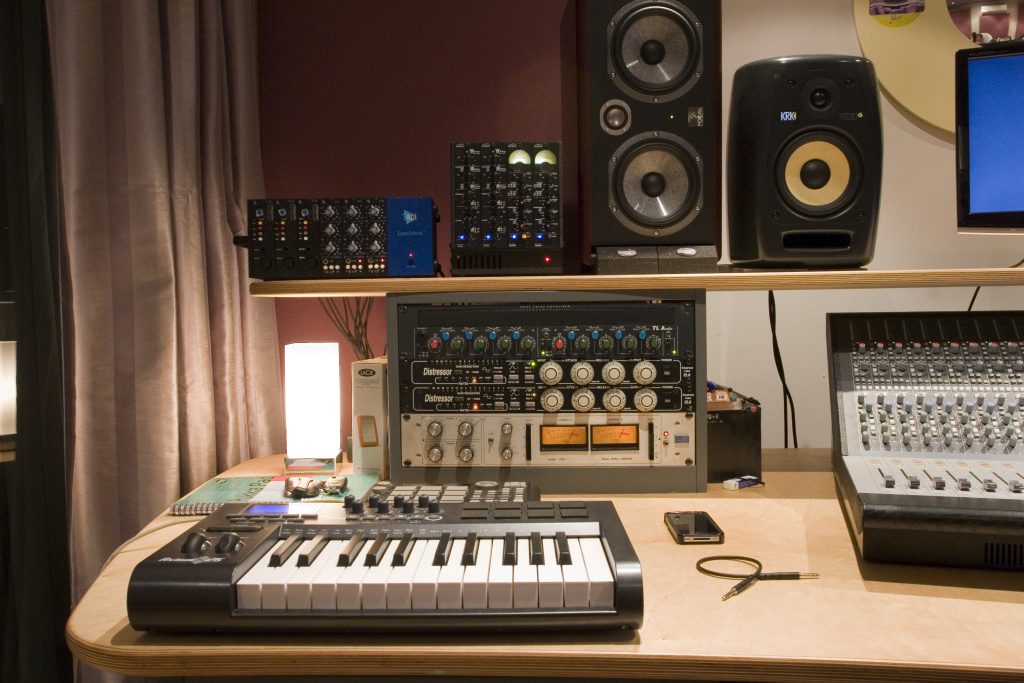
Some of Stephen’s processing gear
The Bunker Equipment List
Console:
Audient ZEN 16MPMF
Recording:
Pro Tools HD3 Accel 8 inputs/24 outputs
Apple 23-inch HD cinema display
Apple Mac Pro 2.66 GHz Quad-Core Intel Xeon, 5Gb DDR3 RAM, 2 x 1TB HDD 7200rpm
Avid 192 16 In/8 Out
Avid HD I/O 8 In/16 Out
Emagic Unitor 8 synchronizer
LG 22-inch widescreen monitor
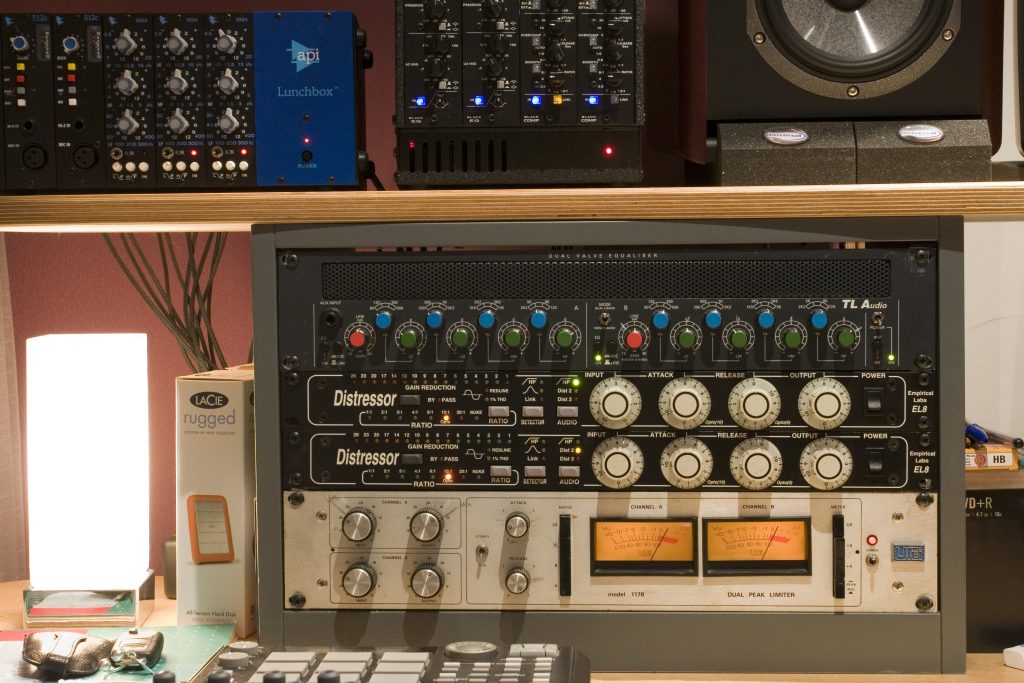
Distressors
Monitoring:
Focal Twin 6 BE active near-field monitors
KRK VXT 6 monitors
Processors:
Audient Black Series Black Comp (x2)
DBX 160X (x2)
Empirical Labs EL8 Distressor (x2)
Urei 1178 compressor
API 550A discrete 3-band EQ (x3)
Audient Black Series EQ (x2)
TL Audio EQ-1 dual valve EQ
API 512C mic preamp (x3)
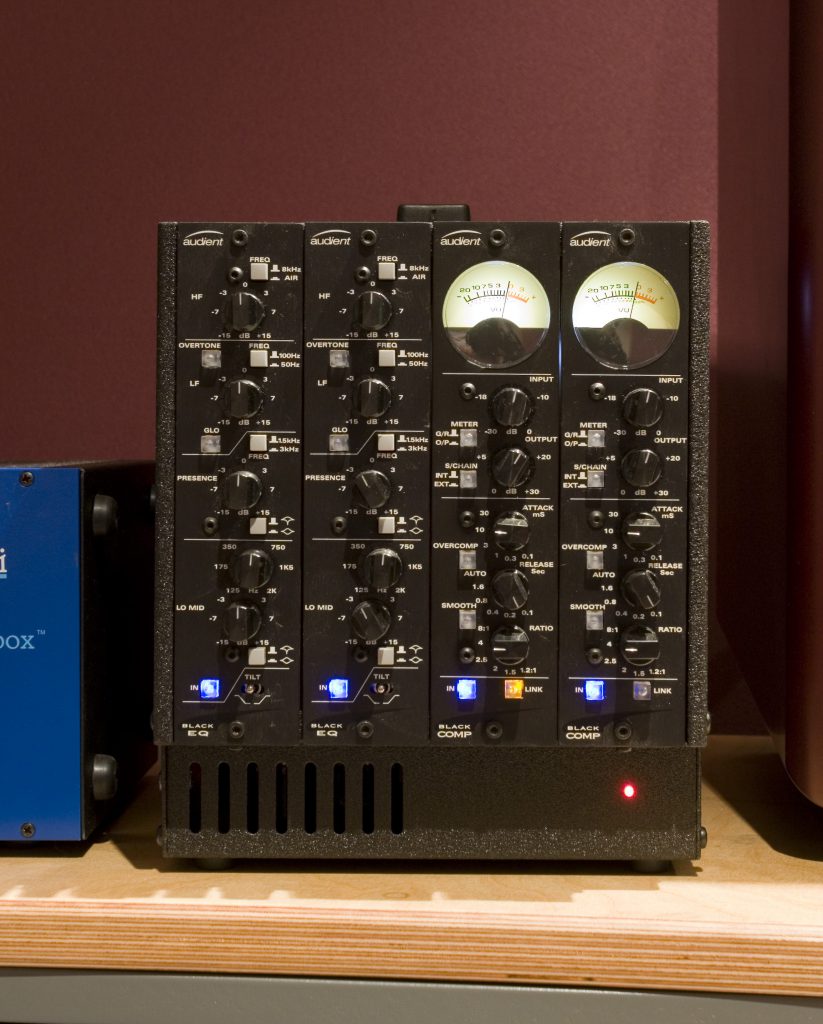
Audient Black Series
Effects:
Lexicon PCM80 reverb
Yamaha SPX900 reverb
Zoom 1210 reverb
Line 6 Echo Pro delay
Mutronics Mutator
Thermionic Culture Vulture
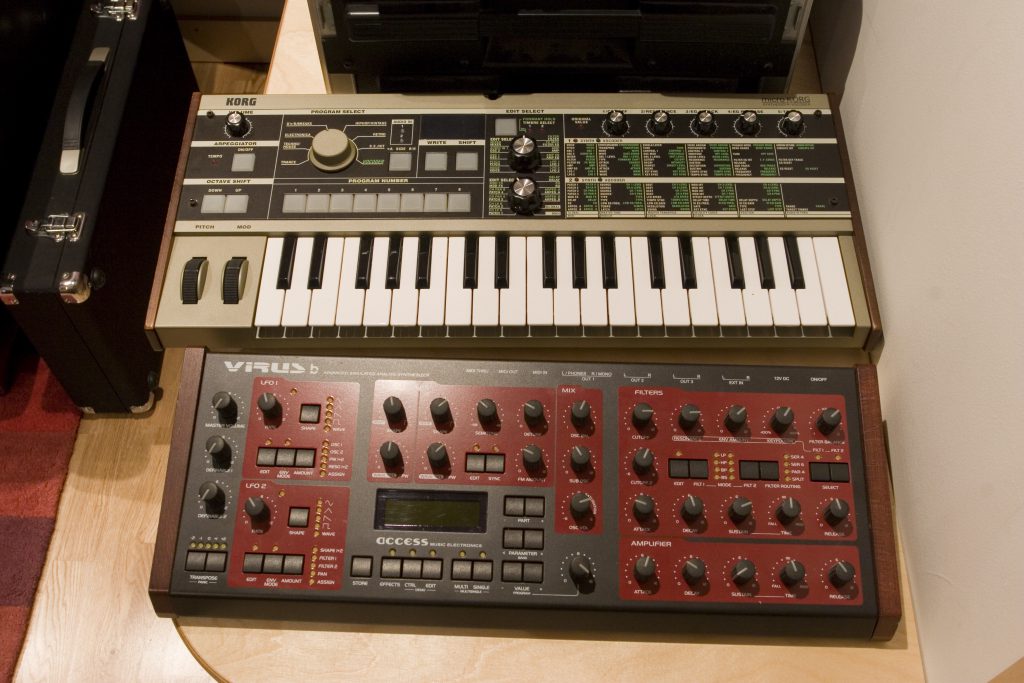
Synths
Keyboards/modules/samplers:
Akai MPC500
E-MU Proteus FX
E-MU Vintage Keys
Korg MicroKorg
M-Audio Axiom 25 MIDI controller
Novation Bass Station (rack)
Roland Super JV1080
Voce Electric Piano
Instruments:
Fender Junior Pro
Fender Telecaster (1975)
Gibson Melody Maker electric (1966)
RhythmTech RT1010 Tambourine
Vox AC15 CC1X Custom Classic
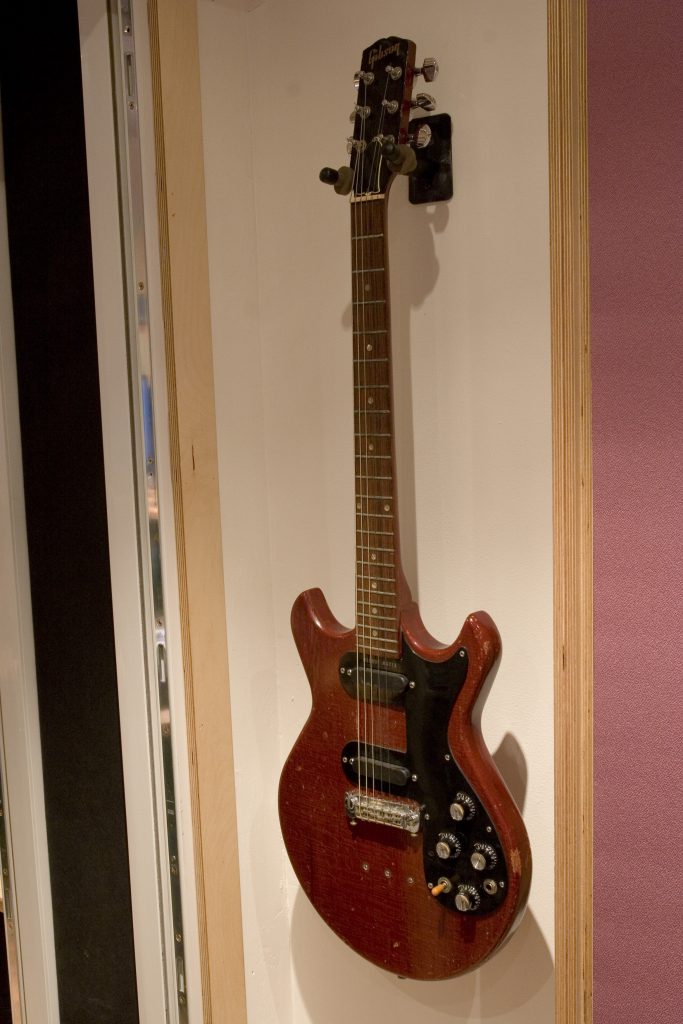
1966 Gibson Melody Maker
Microphones:
AKG D 112
Beyerdynamic M 201 Hypercardioid Dynamic (TG)
Shure SM57
Shure SM58
Shure SM7B
Backup media:
CD-R
DVD-R
AIT2
DDS4
Software:
Apple Logic Pro 9
Apple OSX 10.6.6
Avid Pro Tools 9
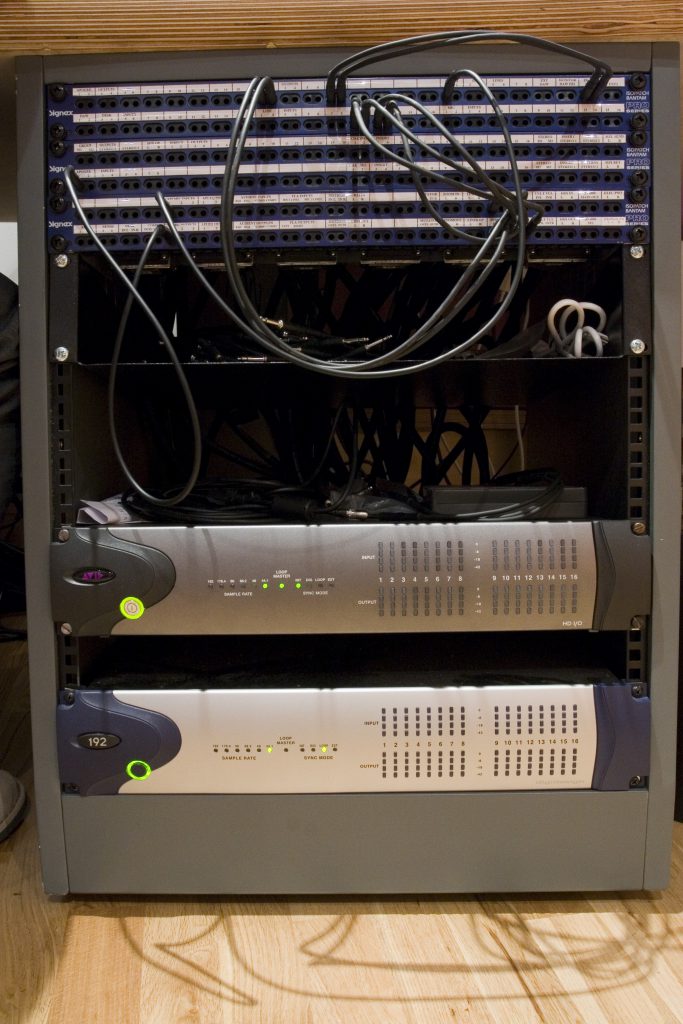
Avid rack and patchbay
Plugins:
Antares Auto-Tune Evo
Avid 7-Band EQ III
Avid AIR Effects Bundle:
Avid AIR Chorus
Avid AIR Distortion
Avid AIR Dynamic Delay
Avid AIR Enhancer
Avid AIR Ensemble
Avid AIR Filter Gate
Avid AIR Flanger
Avid AIR Frequency Shifter
Avid AIR FuzzWah
Avid AIR KillEQ
Avid AIR Lo-Fi
Avid AIR Multi-Delay
Avid AIR MultiChorus
Avid AIR Nonlinear Reverb
Avid AIR Phaser
Avid AIR Reverb
Avid AIR Spring Reverb
Avid AIR StereoWidth
Avid AIR Talkbox
Avid AIR Vintage Filter
Avid BF Essentials Meter Bridge
Avid BF Essentials Noise Meter
Avid Bomb Factory Classic Compressors Bundle v8
Avid Bomb Factory BF-2A
Avid Bomb Factory BF-3A
Avid Bomb Factory Fairchild 660
Avid Bomb Factory Fairchild 670
Avid Bomb Factory Purple Audio MC77
Avid Bomb Factory Cosmonaut Voice
Avid Bomb Factory JOEMEEK Bundle
Avid Bomb Factory JOEMEEK SC2
Avid Bomb Factory JOEMEEK VC5
Avid Bomb Factory moogerfooger Bundle
Avid Bomb Factory Moogerfooger 12-Stage Phaser
Avid Bomb Factory Moogerfooger Analog Delay
Avid Bomb Factory Moogerfooger Lowpass Filter
Avid Bomb Factory Moogerfooger Ring Modulator
Avid Bomb Factory Pultec Bundle
Avid Bomb Factory Pultec EQH-2
Avid Bomb Factory Pultec EQP-1A
Avid Bomb Factory Pultec MEQ-5
Avid Bomb Factory Tel-Ray Variable Delay
Avid Bruno/ Reso
Avid Click
Avid DigiRack D-Verb
Avid DigiRack Dither
Avid DigiRack Dynamics III
Avid DigiRack Mod Delay II
Avid DigiRack TimeAdjuster
Avid DigiRack Trim
Avid Eleven
Avid Impact
Avid Lo-Fi
Avid Maxim
Avid POWr Dither
Avid Pitch
Avid Recti-Fi
Avid Reel Tape Suite
Avid Reverb One
Avid SansAmp PSA-1
Avid Sci-Fi
Avid Signal Generator
Avid TL AutoPan
Avid TL EveryPhase
Avid TL InTune
Avid TL MasterMeter
Avid TL Space – TDM Edition
Digidesign Heat
FXpansion BFD Lite
Massey Plug-In Bundle
Massey CT4 Compressor
Massey DRT Drum Replacement Tool
Massey De:Esser
Massey L2007 Mastering Limiter
Massey TD5 Tape delay
Massey THC Distortion Stompbox
Massey Tape-Head Saturation
Massey VT3 Equalizer
Soundtoys EchoBoy
Waves CLA-2A
Waves CLA-3A
Waves CLA-76 Blacky
Waves CLA-76 Bluey
Waves L2 Ultramaximizer
Waves SSL 4000 Collection
Waves SSL E-Channel
Waves SSL G-Channel
Waves SSL G-Equalizer
Waves SSL G-Master Buss Compressor
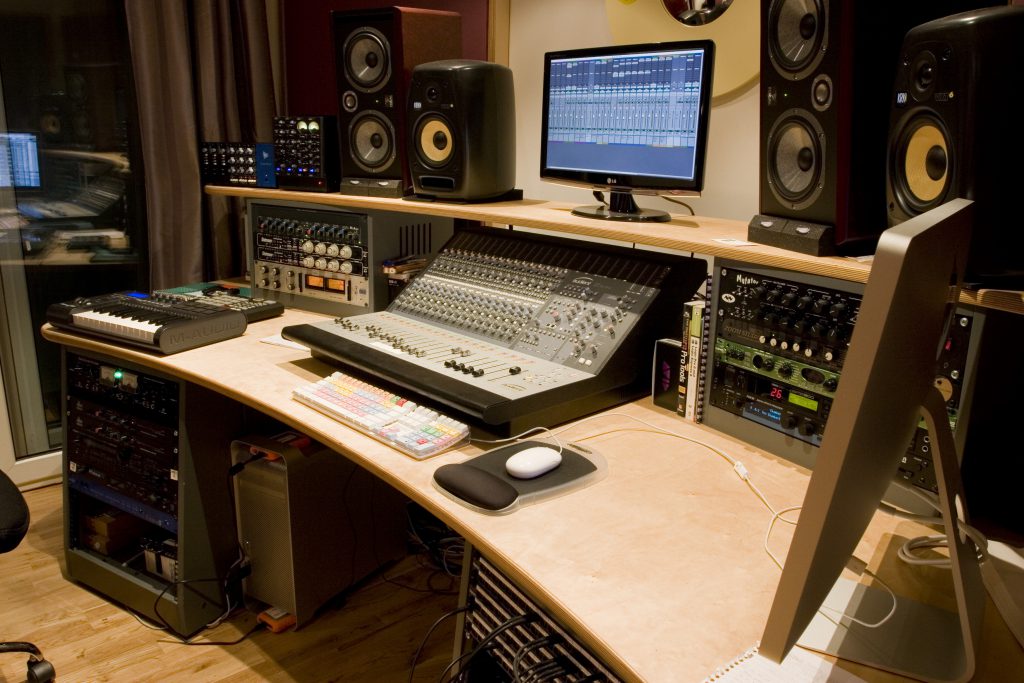
The Studio
Part 1 of our interview with Stephen can be found here: Part 1


